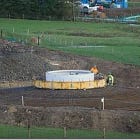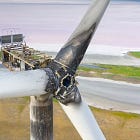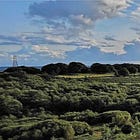"Farmers Rejecting Wind Power Projects to Avoid Massive Clean Up Costs"
“A confidential proposal to build one of Australia’s biggest wind farms on the Western Downs has been knocked back by several landholders due to concerns over decommissioning.”
The following is an important article published by Australia’s Stop These Things on 8 October 2023 which I happened upon whilst looking for something else about industrial wind turbines.
At one of novice “renewable energy developer” Bute Energy’s recent “consultations” i.e. marketing events, I asked one of their representatives if there was a decommissioning fund for their proposed “energy parks” atop the ancient sacred hills of the Radnor Forest which they have named, Nant Mithil Energy Park, along with Aberedw Hill and and Bryn Gilwern. He responded that no there wasn’t a decommissioning fund but rather separate decommissioning agreements with each of the landowners who agreed to lease their land to install monster 220m (722 ft) tall industrial wind turbines on their land. This size of wind turbines has only previously been used offshore.
We know for a fact that there isn’t a ring-fenced decommissioning fund in place at the end of notorious Hendy Wind Farm’s life – if it ever operates! – because Penybont Community Council was finally advised of this after several years chasing Powys County Council Planning department for responses to questions posed during a special Hendy Wind Farm meeting held by Powys County Council’s Planning department in May 2019, which I attended.
If the landowners who sold their souls for the sake of £££ to construct Hendy Wind Farm’s 7 wind turbines on their land - using 2nd hand 110m tall Vestas – do not have separate decommissioning agreements with the developer and/or owners of Hendy Wind Farm this means that they will be responsible for the huge cost of decommissioning the bird, bat, insect and environment destroying things.
Photo of Hendy Wind Farm taken from Castell Crugeryr Motte and Bailey Castle just before it began to rain much more heavily. • 16 March 2024 by Azra Dale
Please read the following article published by Stop These Things, 8 October 2023 which includes a September 2023 article by Brandon Long regarding Vestas’ proposed Tara wind farm project in Australia.
“A confidential proposal to build one of Australia’s biggest wind farms on the Western Downs has been knocked back by several landholders due to concerns over decommissioning.”
Farmers Rejecting Wind Power Projects to Avoid Massive Clean Up Costs
Farmers are rejecting offers to host wind turbines to avoid being left with the massive cleanup costs after these things grind to a halt. At first blush, being paid an annual license fee of $10-25,000 per turbine, per year sounds lucrative enough. However, put that against the $600,000 plus cost of demolishing and removing a single turbine, and the deal soon loses its gloss. Indeed, the ultimate multi-million-dollar cost of removing dozens of turbines from a farming property, makes the piddling revenue stream look like chump change.
With plenty of evidence to show that these things have an economic lifespan of around 15 years – not the wildly ambitious 25 years touted by the wind industry – farmers considering signing up to 25-year landholder agreements have good reason to think hard before they sign.
Demolition and removal is a specialist and, accordingly, expensive enterprise: Demolition Squad: What Happens to Worn Out Wind Turbines? They Get Blown to Bits
STT has been providing warnings to the gullible and unwitting farmer for some time now: Blown Away: Counting the Colossal Cost of Cleaning Up ‘Clean’ Energy’s Monstrous Mess
Well, it seems that at least some of them have taken notice.
More recently, a group called AgForce – representing Queensland’s cane, cattle, grain and sheep, wool & goat producers – has also been providing sensible advice and timely assistance to those contemplating signing landholder agreements with wind power outfits.
We’ll return to AgForce in a moment, with an extract from their submission to the Queensland government regarding decommissioning costs, among other things, but first here’s a story from Queensland Country Life about sensible farmers rejecting the ‘opportunity’ to be left with a colossal cleanup bill when these things give up the ghost in a decade or so from now.
Vestas Tara wind farm project rejected by several landholders
Queensland Country Life
Brandon Long
20 September 2023A confidential proposal to build one of Australia’s biggest wind farms on the Western Downs has been knocked back by several landholders due to concerns over decommissioning.
Danish company Vestas is proposing to develop a 1200MW, 167-turbine wind farm south of Tara, with the aim to start construction by 2027.
For comparison, Acciona Energia’s 1026MW, 180-turbine MacIntyre Wind Farm near Warwick will be the biggest in the Southern Hemisphere when finished in 2024.
The Vestas Tara Wind Farm Project brochure given to landholders says “the decommissioning of a wind farm at the end of project life is the responsibility of the wind farm owner”. While there are no documented decommissioning examples in Australia, some plans have calculated costs between $400,000 – $600,000 per turbine, according to the Australian Energy Infrastructure Commissioner.
The AEIC says most planning permits require decommissioning responsibilities to rest with the project owner, however, in the event of default by the project owner, the liability for decommissioning ultimately may rest with the landholder.
Tara farmer Kieran Cook, who has been approached by Vestas to host wind turbines, said it was too risky. “There is a very high risk that we will be left with the cleanup cost of the wind farm and at $600,000 or more per turbine, it is a risk we are not prepared to take,” Mr Cook said.
Cam Benjamin owns a grazing property within the proposed Tara wind farm as well as property to the west. At the end of 2022, he hosted a meeting of 15 landholders at his property to consider the proposal in his area.
“A unanimous decision was reached to reject the wind farm proposal primarily because of the decommissioning risk,” Mr Benjamin said. “I believe that developers are selling their proposals in the early stages of development and their reluctance to provide security up front for decommissioning is a clear indication that they fully understand the cost of that process. They are therefore exposing landholders to this risk. This risk is unaffordable and makes future planning extremely difficult.”
Brett Wilson runs a broad scale farming operation and his properties adjoin stage one and are also included in the proposed stage two area. He has joined with his neighbours to refuse to host wind turbines, saying it is likely that the wind farm will be traded to an entity that is not equipped to decommission a wind farm of this scale.
Vestas was contacted for comment but did not respond by deadline.
On Monday, Nationals leader and Federal Member for Maranoa David Littleproud told the Rural Queensland Today podcast he had a “big issue” with the uncertainty of wind turbine decommissioning. “I’ve … got a big issue about what happens at end of life and I’m really concerned about farmers getting left with this,” Mr Littleproud said. “They all go, ‘oh, we’ve got a tight contract’, but who’s the contract with at the end in 20 years time? … it’ll be a shell company that has no assets and in fact you’re left with these big turbines you have to decommission.”
Queensland Country LifeNow to AgForce, a group of very switched-on primary producers who have recognised that their kind have been taken for fools, for far too long. Here’s an extract of their recent submission to the Queensland government, which is bang on:
AgForce is a peak organisation representing Queensland’s cane, cattle, grain and sheep, wool & goat producers. AgForce’s purpose is to advance sustainable agribusiness and strives to ensure the long-term growth, viability, competitiveness and profitability of these industries. AgForce recently reviewed and proposed changes to the current Wind Farm Code (State Code 23) in Queensland, which included a section of the decommissioning of wind turbines:
2. Decommissioning
The Code does consider that at the end of the project the requirement that the wind farm site will be returned, as much as practically possible, to its original condition. However, there is little guidance and protection provided to landholders in this space.AgForce takes issue with the lack of guidelines surrounding the decommissioning of wind farms within Code 23.
Whilst it is a condition of the development approval that the preparation of an end of operation decommissioning management plan be submitted to SARA before the wind farm is decommissioned, we do not see that this is sufficient to adequately protect the interest of landholders.
Although some project operators include a clause in their contracts to create a trust fund to deposit the funds to decommission the project into, this is usually not contemplated to commence until towards the end of the project life, such as year 15, 20 or 25. This opens the landholder up to a number of risks.
The Australian Energy Infrastructure Commissioner has referred to the event where the project owner defaults on the agreed conditions which therefore results in the liability for decommissioning the project falling to the landholder. Under section 73 of the Planning Act, the development approval binds the original owner of the premises, the owners’ successors in title and any occupier of the premises. The ramifications of such an occurrence are manifold. The AEIC has also highlighted that the project operator may sell the project to another company over the course of the life of the project, which could easily result in the arrangement to fund the decommissioning being lost and the enforceability of the agreement being eroded over time. There is nothing in the Planning Act to provide for the development approval to bind the wind farm proponent/developer once it transfers the wind farm, or the successors in title to the wind farm or the holding company of the proponent. Often the wind farm proponent/developer is a $2 subsidiary of a publicly listed company with no resources to fulfill the conditions – particularly the decommissioning condition.
The AEIC website states that the cost to decommission each wind turbine ranges from $400,000- $600,000, depending on the size of the turbine. This cost could increase vastly if there are structural failures or is unstable, where the AEIC states it could cost millions to remove each turbine from the project site. Concerningly, if the cost to decommission the wind farm did fall upon the landholder, there would likely be no avenue for the landholder to recover the costs of decommissioning the project as they would not have ownership over the project’s assets. AgForce sees that if such a cost was put onto the landholder that this would be overly burdensome and almost impossible to undertake in some circumstances. Plainly, it is completely unacceptable that this is even a possibility with the current guidelines.
2.1 Recommendations in Response to Decommissioning
It be mandatory for the proponent/developer to commence funding a decommissioning trust fund from the project’s commencement, as it would be easier to obtain significant funding earlier on in the project life.
Developer to organise for a bank guarantee, sinking fund, trust fund or a security bond deposit to be held by the landowner throughout the life of the project, so that landholders can have confidence that funds are being put aside by the proponent/developer.
Clarity that any agreement between the original proponent/developer will be carried over to be an agreement between the landholder and any new company that buys the project.
AgForce notes that analogous requirements exist in Queensland’s mining industry legislation, the EP Act9 and federally in the offshore mining space.
AgForce is not recommending any requirements that are not already in existence in similar circumstances, hence it would seem that such a request would be wholly reasonable to impose upon wind farm proponents/developers.
You can read the full AgForce submission here: AgForce – State Code 23 submission (PDF)
For some background information regarding novice Scottish renewable energy developer Bute Energy who have never before constructed a single wind turbine, please see the following previous posts.












